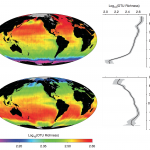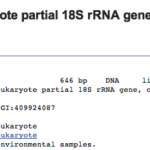Bringing you some awesome ocean sounds this Friday–nope, not crashing waves or squawking seagulls (boo hiss for vertebrates). These sounds come from MICROBES! Peter Larsen and colleagues at Argonne National Lab (home of the gargantuan Earth Microbiome Project) have turned their huge DNA sequence datasets into music. Listen to the jazzy samplings below (video), and scroll down for science-y explanations of each musical theme.
Descriptions of each melody from the Argonne Lab Website:
Blues for Elle: This composition highlights seasonal patterns in marine physical parameters at the L4 Station. The chords are generated from seasonal changes in photosynthetically active radiation. The melody of each measure is comprised of eight notes, each mapped to a physical environmental parameter, in the following order: temperature, soluble reactive phosphate, nitrate, nitrite, saline, silicate, and chlorophyll A concentrations.
Bloom: Some marine microbial taxa are most often present in the L4 Station community at very low abundance, but occasionally become highly dominant community members. To link these microbial blooms to relevant physical parameters, the chords in this composition are derived from changes in chlorophyll A concentrations and salinity. The melody for each measure is derived from the relative abundances of typically rare taxa that were observed to occasionally bloom to higher abundance in the following order: Cyanobacteria, Vibrionales, Opitulates, Pseudomondales, Rhizobiales, Bacillales, Oceanospirallales, and Sphingomonadales.
Far and Wide: Microbial species of the Order Rickettsiales, such as the highly abundant, free-living planktonic species Pelagibacter ubique, are typically, highly abundant taxa in L4 Station data. Its relative abundance in the microbial community at L4 Station follows a distinctive seasonal pattern. In this composition, there are two chords per measure, generated from photosynthetically active radiation measurements and temperature. The melody of each measure is six notes that describe the relative abundance of the Order Rickettsiales. The first note of each measure is from the relative abundance at a time point. The next five notes of a measure follow one of the following patterns: a continuous rise in pitch, a continuous drop in pitch, a rise then drop in pitch, or a drop then rise in pitch. These patterns are matched to the relative abundance of Rickettsiales at the given time point, relative to the previous and subsequent time points. The pattern of notes in a measure is mapped to the relative abundance of Rickettsiales with fewer rests per measure indicating higher abundance. For time points at which Rickettsiales was the most abundant microbial taxa, the corresponding measure is highlighted with a cymbal crash.
Fifty Degrees North, Four Degrees West: All of the data in this composition derives from twelve observed time points collected at monthly intervals at the L4 Station during 2007. The composition is composed of seven choruses. Each chorus has the same chord progression of 12 measures each in which chords are derived from monthly measures of temperature and chlorophyll A concentrations. The first and last chorus melodies are environmental parameter data as in ‘Blues for Elle’. The melody in each of the second through sixth chorus is generated from the relative abundances of one of the five most common microbial taxa: Rickettsiales, Rhodobacteriales, Flavobacteriales, Cyanobactera, and Pseudomondales. A different ‘instrument’ is used to represent each microbial taxon. Melodies for microbial taxa were generated as in ‘Far and Wide’.






Hey now, I’m a vertebrate, and I’ve made some music in my time. ;)